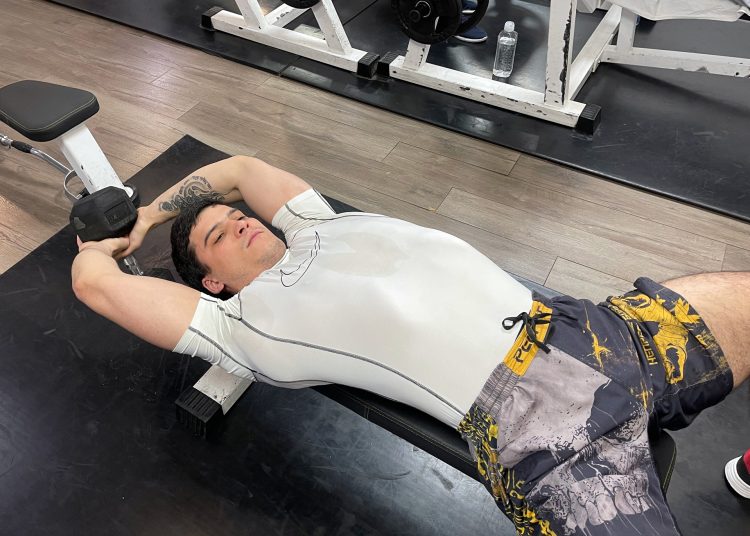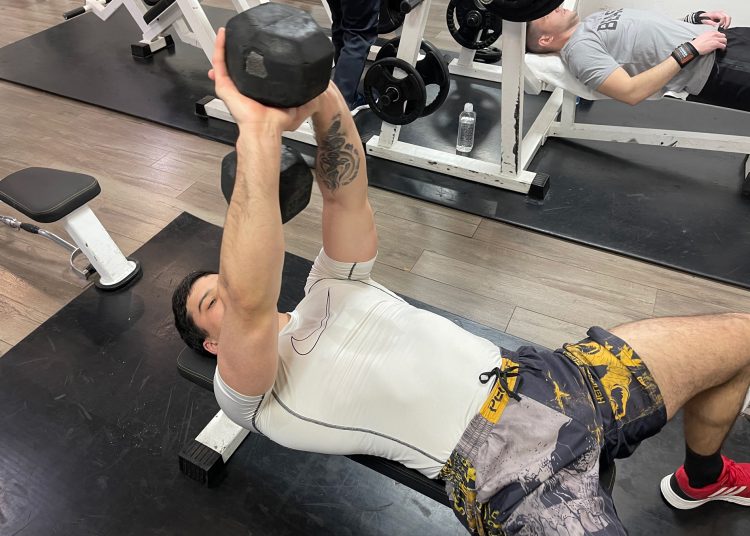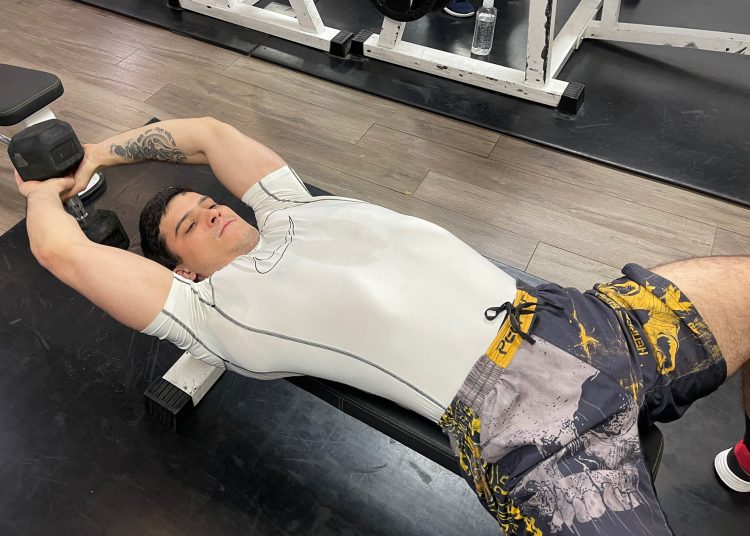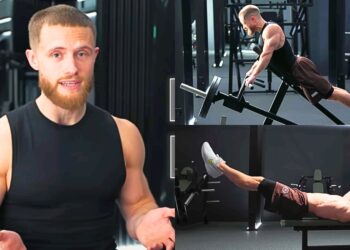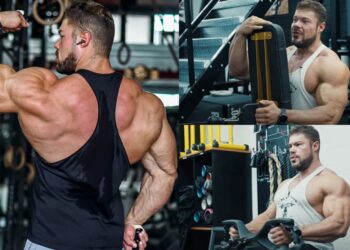Overhead pulling exercises are the most effective for crafting a back that is as wide as a billboard. However, building a broad back can be challenging, especially if you have a lagging posterior chain.
Many people, especially those who train in a bare-bone home gym, ask me if they can substitute lat pulldowns with dumbbell pullovers.
So, the question remains: can dumbbell pullovers replace lat pulldowns? Also, can you grow your lats and other upper back muscles equally or more effectively with dumbbell pullovers?
In this article, I will explain why you should pick dumbbell pullovers over lat pulldowns. Let’s start with why I believe the dumbbell pullover can be as effective, if not more, compared to the lat pulldown.
Why are Dumbbell Pullovers an Effective Substitute for Lat Pulldowns?
Here are some of the main reasons why dumbbell pullovers are an effective lat pulldown substitute:
Level Up Your Fitness: Join our 💪 strong community in Fitness Volt Newsletter. Get daily inspiration, expert-backed workouts, nutrition tips, the latest in strength sports, and the support you need to reach your goals. Subscribe for free!
Target Muscle Groups
The truth is that lat pulldowns and dumbbell pullovers will effectively target your lats. However, dumbbell pullovers also target some additional muscles.
For example, dumbbell pullovers will additionally target the serratus anterior, pectoralis major, and triceps brachii. Now, if you have a similar training philosophy as me, then you will embrace this fact because you can easily target antagonistic muscle groups in the same exercise.
This is why I believe you must implement the dumbbell pullover towards the end of the workout. Also, you learn how to use all these muscles synergistically to perform the movement. This is another reason why I classify pullovers as a more functional exercise compared to lat pulldowns.
Range of Motion
Visualize both pulldowns and pullovers for a second. Where are your arms positioned in the end range of motion for both exercises? If you visualize it correctly, you can notice that dumbbell pullovers offer an additional range of motion in the shoulder joints.
Pullovers allow for an extended range of shoulder flexion, exceeding the 180-degree angle, a feat not achievable with pulldowns. Also, this is quite useful because deeper muscle stretch correlates with better muscle hypertrophy. (1)
The more you can stretch your muscle during the eccentric phase, the more signals you will send to your brain, resulting in better muscle hypertrophy.
Also, the overhead position is the most challenging position in dumbbell pullovers. In that sense, you place the most significant amount of stretch and force in the most stretched position, which is also great for hypertrophy and strength.
Versatility
Versatility is another big thing nobody talks about. You can’t perform lat pulldowns anywhere you want; you need a dedicated lat machine. On the other side, you can perform dumbbell pullovers almost anywhere you want. You just need a dumbbell and some form of flat bench or even a plyo box, depending on your preferences.
Functional Movement
The dumbbell pullover is more functional than lat pulldowns. During lat pulldowns, you are in a stable seated position. The only thing you must do is pull the bar toward your collarbone.
This can be great for biasing the lats and promoting hypertrophy, but it is not the most optimal for building overall functionality. Conversely, the dumbbell pullover, executed with a free weight, introduces a level of instability.
You must consciously stabilize your trunk and extremities to remain balanced and move the dumbbell in the desired line of pull.
Core Engagement
The dumbbell pullover engages your core musculature much more than the lat pulldowns. This ties nicely with my previous point about functional strength and real-life scenarios. You will effectively teach your core to stabilize your body during complex movements.
This is especially useful for injury prevention and remaining stable, which is quite useful for precision and other related motor abilities. (2)
Also, this is one of the reasons I recommend athletes and people indulging in recreational sports to use the dumbbell pullover instead.
You will build strength and endurance, which you can actually use on the court/field.
Variability
The dumbbell pullover offers solid variability. This means you can adjust the exercise to suit your current goals. For example, you can perform a bigger or smaller range of motion, change the trajectory of the weight slightly to target different back muscles, or use two weights instead of one for better grip strength and core stability.
You can also perform the dumbbell pullover on different surfaces and incline levels, allowing for a more nuanced approach and better muscle targeting.
How To Do a Dumbbell Pullover for Maximal Lat Growth
Here is how to do a dumbbell pullover for maximal lat growth:
Step One — Assume the Starting Position
Pick a dumbbell of an appropriate weight. Lie on your back on the flat bench. Extend the dumbbell above your chest and firmly place your feet on the ground. Contract your core muscles for better balance.
Pro Tip: Don’t lock out your elbows. I recommend keeping them slightly bent throughout the entire exercise. This will avoid placing additional stress on the elbow joints.
Step Two — Reach Backward
Slowly reach backward by bending your shoulder joint and driving the dumbbell behind your head and towards the floor in a sweeping motion. Ensure your feet stay in contact with the ground and contract your core for better stability.
Reach the dumbbell as far toward the floor as possible. The goal is to stretch your lats as much as you can. Hold the bottom position for one second.
Level Up Your Fitness: Join our 💪 strong community in Fitness Volt Newsletter. Get daily inspiration, expert-backed workouts, nutrition tips, the latest in strength sports, and the support you need to reach your goals. Subscribe for free!
Pro Tip: If you want to make the end range of motion even more challenging, try holding it for more than 2 or 3 seconds. Static stretching can help promote muscle hypertrophy.
Step Three — Raise the Dumbbell and Repeat
Slowly return the dumbbell to the starting position above your chest. Repeat the whole process for additional reps.
Pro Tip: Perform this concentric phase with a fast but controlled motion. This is quite useful for athletes looking to develop additional explosive strength.
Tips for Making the Dumbbell Pullover as Effective as the Lat Pulldown
Here are a few tips to get the best bang for your buck from dumbbell pullovers:
Proper Form
Ensure proper stability and positioning of your body when lying on the bench. Aim for your hips to be slightly lower than your knees. Also, keep your elbows fixated in the slightly bent position during the entire movement and only move at your shoulder joint. This will prevent compensatory movements and other muscles from getting more active during the exercise.
Controlled Movement
Avoid jerky movements and dropping the dumbbell to the ground. You want to keep the tension in the target muscles throughout the full range of motion, especially where your lats are the most stretched. Aim for around 3 seconds of lowering for maximal time under tension and to promote hypertrophy.
Full Range of Motion
Perform the movement with a full range of motion. Not going as deep as you can during the lowering phase is a no-no. Stretch your lats throughout at the bottom for maximal benefits.
Engage Your Core
Engage your core musculature for better stability and balance throughout the exercise. This entails actively keeping your abdominal and hip muscles contracted throughout the entire movement.
Breathe Properly
Slowly inhale as you lower the dumbbell behind your head and towards the floor. As you bring the dumbbell from the bottom position to the top position above your chest, sharply exhale and create intra-abdominal pressure to lift the weight more easily.
Focus on the Lats
The key to performing dumbbell pullovers for maximal lat growth is actually consciously thinking about them all the time. This will ensure a better mind-muscle connection.
I know this sounds silly, but I can tell from experience, especially during exercises such as curls and tricep extensions, that focusing on squeezing the target muscles with each rep helps maximize muscle stimulation.
Progressive Overload
Progressive overload is the name of the game if you want to build muscle or strength. You can’t get stronger or build muscle tissue if you stick to the same training volume. You must increase the number of reps, sets, weights, or training sessions to shock your muscles into growing.
Volume and Frequency
For optimal strength gains and muscle growth, I suggest performing 3-4 sets of dumbbell pullovers in your workout. Also, perform dumbbell pullovers at least once or twice weekly for the best results.
Warm-up
I cannot emphasize enough the importance of a proper warm-up, not only before performing dumbbell pullovers but before any workout in general. Elevating your body’s core temperature with light cardio and performing warm-up sets of pullovers can reduce injury risk and enhance performance.
Aim for at least 5 minutes of cardio before every workout to raise your body’s temperature, and perform at least 2-3 warm-up sets before proceeding with heavier working sets.
FAQs
Are pullovers better than lat pulldowns?
Dumbbell pullovers can be better than lat pulldowns in certain scenarios. They are both effective at targeting your lats. However, performing lat pulldowns may be a better solution to build maximal pulling strength. On the other hand, dumbbell pullovers may be a better choice if you are looking for an exercise targeting multiple antagonistic muscle groups simultaneously.
Can pullovers replace lat pulldowns?
I wouldn’t recommend substituting lat pulldowns with dumbbell pullovers, as you can lift significantly more weight with lat pulldowns, which helps build strength and power. Also, you never want to limit yourself to a few exercises because that often leads to a plateau.
Do pullovers and pulldowns work the same muscles?
Pullovers and pulldowns both target similar muscle groups, with a particular focus on the lats. In addition to that, pullovers also target the triceps brachii and pectoralis major.
Should I go heavy on pullovers?
You should go heavy on dumbbell pullovers only after you’ve mastered the exercise technique. There’s little benefit of lifting too heavy if your form can’t keep up with the increased resistance.
You risk injury, impaired performance, or internalizing incorrect movement mechanics, which can result in compensatory movements and additional complications.
Are dumbbell pullovers good for hypertrophy?
The dumbbell pullovers are actually good for hypertrophy. However, you must follow the recommended hypertrophy training principles. These include performing at least 3-4 sets of 8-12 reps and resting between 30 and 90 seconds between sets. (3)
Also, you should pick a weight that is between 67.5% and 85% of your 1RM for maximal muscle growth stimulation.
Wrapping Up
The dumbbell pullover is an excellent back exercise that targets your lats, chest, and triceps. You can substitute lat pulldowns with dumbbell pullovers if you program your workouts properly and follow the recommended hypertrophy training principles.
I personally perform dumbbell pullovers towards the end of my back workout and focus on targeting the bottom portion of the movement for a deep lat stretch.
In the comments below, let me know your thoughts and whether you believe dumbbell pullovers can effectively substitute lat pulldowns.
References:
- Krzysztofik M, Wilk M, Wojdała G, Gołaś A. Maximizing Muscle Hypertrophy: A Systematic Review of Advanced Resistance Training Techniques and Methods. Int J Environ Res Public Health. 2019;16(24):4897. Published 2019 Dec 4. doi:10.3390/ijerph16244897
- Huxel Bliven KC, Anderson BE. Core stability training for injury prevention. Sports Health. 2013;5(6):514-522. doi:10.1177/1941738113481200
- Schoenfeld BJ, Grgic J, Van Every DW, Plotkin DL. Loading Recommendations for Muscle Strength, Hypertrophy, and Local Endurance: A Re-Examination of the Repetition Continuum. Sports (Basel). 2021;9(2):32. Published 2021 Feb 22. doi:10.3390/sports9020032
Relevant Articles:
Article Updates Timeline:
Our editorial team experts constantly update the articles with new information & research, ensuring you always have access to the latest and most reliable information.
February 25, 2024
Written By
Vanja Vukas
Edited By
Vidur Saini
Fact Checked By
Dr. Malik
Interested in measuring your progress? Check out our strength standards for Dumbbell Pullover, Tricep Extension, Lat Pulldown.

